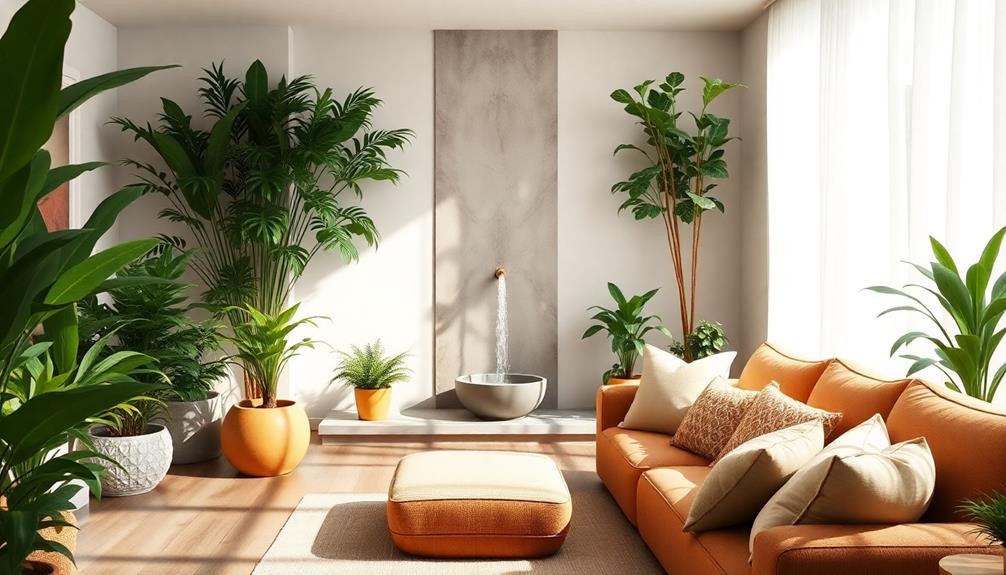To create a calming interior for your mental wellness, choose soft, soothing colors like blues and greens that promote relaxation. Arrange furniture to maximize openness, avoid clutter, and allow natural flow to reduce visual stress. Keep the space simple and peaceful by minimizing overstimulation with minimal decor. Incorporating elements like calming lighting or technology can enhance tranquility. If you keep exploring, you’ll discover more ways to design spaces that nurture your mental health effectively.
Key Takeaways
- Incorporate soft, calming colors like blues and greens to promote relaxation and reduce stress.
- Arrange furniture to create open, uncluttered spaces that facilitate natural flow and ease of movement.
- Minimize clutter and avoid overly vibrant hues to prevent overstimulation and foster tranquility.
- Use intentional design elements, such as comfortable seating and appropriate lighting, to support mental comfort.
- Integrate technology and peaceful decor choices to enhance relaxation zones and nurture emotional well-being.

Have you ever wondered how the spaces around you influence your mood and mental health? The way a room is designed can considerably impact how you feel throughout the day. One of the most effective ways to foster calm and clarity is through understanding color psychology. Different colors evoke specific emotions; for example, soft blues and greens are known to promote relaxation, reduce stress, and create a sense of tranquility. When you choose calming colors for your walls, furniture, and accessories, you help establish a peaceful environment that encourages mental well-being. These hues aren’t just aesthetically pleasing—they actively work to soothe your mind, making your space a sanctuary rather than a source of overwhelm.
Beyond color, furniture arrangement plays an essential role in creating a mentally restorative space. Consider how you position your furniture: cluttered or chaotic layouts can increase feelings of anxiety, while open, organized arrangements foster a sense of order and control. You want your furniture to facilitate easy movement and promote a feeling of spaciousness. For instance, avoid blocking pathways or overcrowding a room with too many pieces. Instead, opt for a layout that allows for natural flow, giving your mind room to breathe. Placing a comfortable chair or sofa in a corner with good lighting can invite relaxation and reflection, while keeping your workspace or cluttered areas out of sight reduces visual stress. Additionally, incorporating elements like projector technology can turn your space into an immersive entertainment or relaxation zone, further enhancing your mental wellness.
The combination of color psychology and smart furniture arrangement can transform any space into a mental wellness haven. Imagine walking into a room painted in gentle, soothing shades and seeing furniture arranged to maximize openness—your mind immediately relaxes, and stress melts away. When you’re deliberate about these choices, you create an environment that not only looks good but also supports your emotional health. Keep in mind that simplicity often leads to serenity. Avoid overcrowding your space with unnecessary items or overly vibrant colors that might stimulate anxiety rather than calm. Instead, focus on a cohesive palette and a layout that feels intuitive and peaceful.
Ultimately, the spaces you inhabit daily influence your mental state far more than you might realize. By paying attention to color psychology and furniture arrangement, you’re actively shaping an environment conducive to mental wellness. Small adjustments—like repainting a wall or rearranging a chair—can have a profound effect on how you feel. When your surroundings promote calm and order, they help nurture your mental health, making your home not just a place to live, but a true sanctuary for your mind.
Frequently Asked Questions
How Do Lighting Choices Affect Mental Health in Interior Design?
Lighting choices markedly impact your mental health by shaping lighting ambiance and enhancing your mood. Soft, warm lighting creates a calming environment, reducing stress and promoting relaxation. Bright, natural light boosts energy and focus, helping you feel more alert. Proper lighting design can prevent eye strain and improve sleep quality. By selecting the right lighting, you support mental wellness, making your space more inviting and conducive to positive feelings.
What Are the Best Natural Materials for Promoting Calmness?
Think of your space as a calming oasis—natural materials are your best bet. Opt for natural fibers like cotton, linen, and wool, which bring organic textures that soothe your senses. These materials aren’t just eco-friendly; they also promote relaxation and mental clarity. Incorporating wood or bamboo adds warmth and grounding energy. Using these elements helps create a tranquil environment, making your space a true haven for peace and calm.
How Can Furniture Arrangement Reduce Stress and Anxiety?
You can reduce stress and anxiety by arranging furniture according to feng shui principles, creating a balanced and harmonious space. Keep clutter-free zones to promote a sense of calm and prevent visual chaos. Position furniture to allow easy movement and natural light flow, enhancing relaxation. Avoid sharp corners and overcrowding, which can create tension. An intentional layout fosters tranquility, making your space a peaceful retreat for mental wellness.
Are There Specific Colors That Improve Focus and Concentration?
Bright blue and soft green are your best choices to enhance focus and concentration through color psychology. These colors reduce mental fatigue and promote calmness, helping you stay attentive. Juxtapose their soothing qualities with the chaos of a cluttered workspace to see how they create a visual focus. By choosing these shades, you actively foster a more productive environment, where your mind stays clear and your tasks become easier to manage.
How Frequently Should Interior Spaces Be Refreshed for Wellness Benefits?
You should refresh your interior spaces every season to maintain wellness benefits. Incorporate seasonal decor to keep the environment lively and engaging, which can boost mood and reduce stress. Additionally, updating wall art periodically helps keep the space inspiring and fresh. Regularly changing these elements encourages a positive atmosphere, supports mental clarity, and guarantees your surroundings continue to promote calmness and focus effectively.
Conclusion
Imagine walking into a space painted in soft, calming hues, where natural light filters gently through the windows, and a cozy nook invites you to relax. When you choose soothing colors and thoughtful layouts, you create a sanctuary that nurtures your mind and soul. Your environment becomes a gentle embrace, helping you find peace amid chaos. With mindful design, you turn your home into a tranquil haven where mental wellness can truly flourish.








